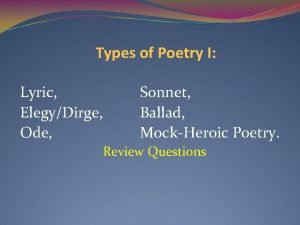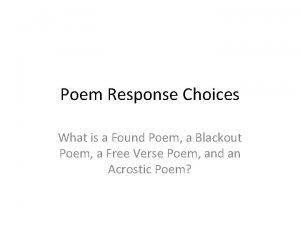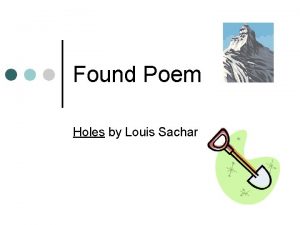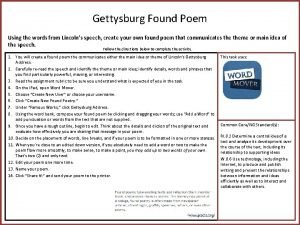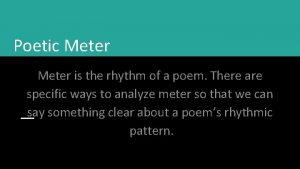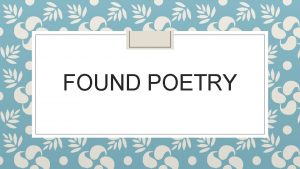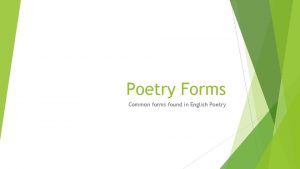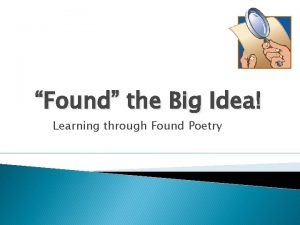Poetry Forms Common forms found in English Poetry










- Slides: 10

Poetry Forms Common forms found in English Poetry

Types of Poetry, just like prose, can come in various styles and forms. Poets will pick a particular type of poetry to convey their emotions or ideas to the reader's or listener's mind or ear. The form a poet chooses to write in can have a major impact as poems frequently rely for their effect on imagery, word choice, and the musical qualities of the language used. Compared with prose, poetry depends less on sentences and paragraphs, and more on organization that will express the poet’s intended meaning and emotions.

Couplets: a successive pair of lines in a poem that rhyme with each other and usually have the same meter. Ex. Twinkle, twinkle, little star, How I wonder what you are. Hush, little baby, don’t you cry. Mama’s gonna sing you a nursery rhyme. There was a time in my youth The best part of waking up is Folgers in your cup.

Limerick: a poetic form that is one stanza with five lines and a rhyme scheme of AABBA. It is usually funny and involves puns. How to write a limerick: The first, second and fifth lines rhyme with each other and have the same number of syllables (typically 8 or 9). The third and fourth lines rhyme with each other and have the same number of syllables (typically 5 or 6) Limericks often start with the line "There once was a. . . " or "There was a. . . " Ex. There once lived a boy near the ocean Who thought he’d found a magical potion He took a big drink And started to think It tasted just like suntan lotion.

Haiku: Japanese poetry that reflects on nature and feelings. There are three lines with five syllables in the first line, seven syllables in the second, and five in the third. Ex. (5) The sky is so blue. (7) The sun is so warm up high. (5) I love the summer. I really like toast. It is yummy when it's hot. I like it best cold. Beans are kind to hearts. I like to eat them almost daily. And then do big farts!

Free Verse Free verse is a type of poetry that does not contain patterns of rhyme or meter. Free verse is considered an open form of poetry, as opposed to poetry written in structure or form, and tends to follow natural speech patterns and rhythms. While some rhyme and rhythm may occur in free verse poems, the poet does not adhere to strict patterns. This doesn’t mean the free verse has no structure, it still contains poetic lines and imagery that make it different from prose.

Free Verse, Cont. Ex. Wind Who wants a pancake, Blowing briskly Leaves fall Good little Grace looks up and says, “I’ll take the on top. ” From…The…Trees Who else wants a pancake, We rake Fresh off the griddle? Colored leaves jump. Sweet and piping hot? In A Big Pile. And Terrible Theresa smiles and says, “I’ll take the one in the middle. ”

Narrative poetry: a form of poetry that tells a story, often making use of the voices of a narrator and characters as well; the entire story is usually written in metered verse. Jimmy was a happy ape Until some hunters caught him He liked the jungle better than The city where they brought him The city was louder The city was meaner Even the dirt in the jungle was cleaner So Jimmy made a daring escape! The hunters were suddenly minus one ape! He climbed the tallest building Because from there he'd see How far away the jungle was From the middle of the city. Jimmy jumped into a passing plane But the pilot didn't wait for him to explain Jimmy flew back to the jungle And told his ape friends in their lair "The city's okay for a visit But you couldn't make me live there. "

Lyric Poetry: consists of a poem, such as a sonnet or an ode, that expresses the thoughts and feelings of the poet. Lyric poetry does not tell a story which portrays characters and actions. The lyric poet addresses the reader directly, portraying his or her own feeling, state of mind, and perceptions. I've had cabbage, lettuce, blackberries Pasta, oats and strawberries Bagels, beans and hot dogs Eggplant, ham and cheese logs I've had pumpkin and potato Truffles and tomato Diced, sliced, cubed and riced Boiled and fried Soaked and dried Burgers, tacos, ice cream too Radishes red and berries blue Despite all this, I'm feeling thinner. . . Still, that was lunch, now what's for dinner?

Descriptive Poetry: the poetic equivalent of a portrait or a landscape painting. It is realistic and does not go into emotions and metaphor. Description in most poems is ornamentation, but in descriptive poetry, it becomes the center of attention. Spaghetti, spaghetti, all over the place, Up to my elbows-up to my face, Over the carpet and under the chairs, Into the hammock and wound round the stairs, Filling the bathtub and covering the desk, Making the sofa a mad mushy mess.
